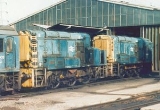
British Rail Class 13
Encyclopedia
The British Rail
Class 13 were created in 1965 because of a necessity to provide more powerful shunters for the Tinsley Marshalling Yard
. This was achieved by permanently coupling together two Class 08
shunters as a 'master and slave' (alternatively 'cow and calf
') units, the latter with its cab removed. Both units were ballasted to improve traction.
Initially the units were coupled cab-to-cab but it was found more practical to couple master nose to slave cab.
The reason that a larger, rigid locomotive could not be used was due to the risk of grounding on the marshalling yard hump.
None of this unusual class survives.
British Rail
British Railways , which from 1965 traded as British Rail, was the operator of most of the rail transport in Great Britain between 1948 and 1997. It was formed from the nationalisation of the "Big Four" British railway companies and lasted until the gradual privatisation of British Rail, in stages...
Class 13 were created in 1965 because of a necessity to provide more powerful shunters for the Tinsley Marshalling Yard
Tinsley Marshalling Yard
Tinsley Marshalling Yard was a railway marshalling yard located near Tinsley in Sheffield. It was opened in 1965 as a part of a major plan to rationalise all aspects of the rail services in the Sheffield area, and closed in stages from 1985 with the run-down of rail freight in Britain. It was also...
. This was achieved by permanently coupling together two Class 08
British Rail Class 08
The British Rail Class 08 is a class of diesel-electric shunting locomotive. From 1953 to 1962, 996 locomotives were produced, making it the most numerous of all British locomotive classes....
shunters as a 'master and slave' (alternatively 'cow and calf
Cow-calf
In North American railroading, a cow-calf locomotive is a set of switcher-type diesel locomotives. The set usually is a pair; some 3-unit sets were built, but this was rare. A cow is equipped with a driving cab; a calf is not...
') units, the latter with its cab removed. Both units were ballasted to improve traction.
Initially the units were coupled cab-to-cab but it was found more practical to couple master nose to slave cab.
The reason that a larger, rigid locomotive could not be used was due to the risk of grounding on the marshalling yard hump.
Units
Three pairs were formed as follows:- Master unit D4190 and Slave unit D4189 to form D4501, later 13001
- Master unit D4187 and Slave unit D3697 to form D4502, later 13002
- Master unit D4188 and Slave unit D3698 to form D4500, later 13003
Withdrawal
With the end of hump shunting at Tinsley the class became obsolete. The unique qualities of the locomotives were not required elsewhere and so withdrawal was inevitable; 13002 went in 1983, with the remaining two locomotives going with the closure of Tinsley hump in 1985.None of this unusual class survives.
- 13001 was scrapped at BREL Swindon Works in May 1985
- 13002 was scrapped at BREL Swindon Works in October 1983
- 13003 was scrapped at BREL Doncaster Works in September 1986

